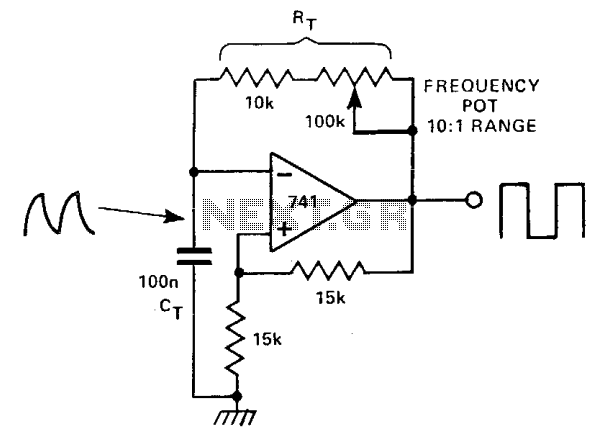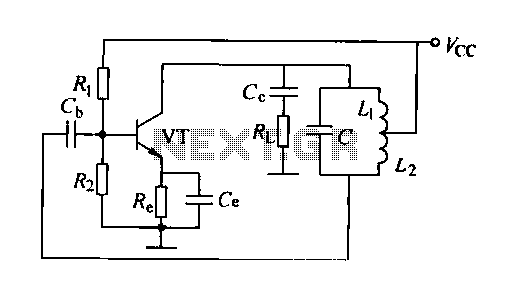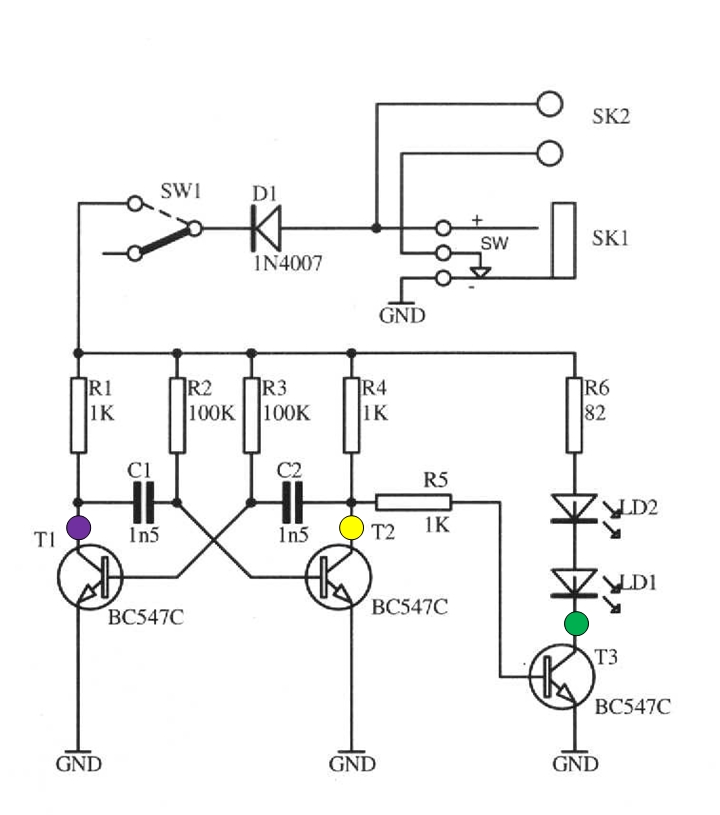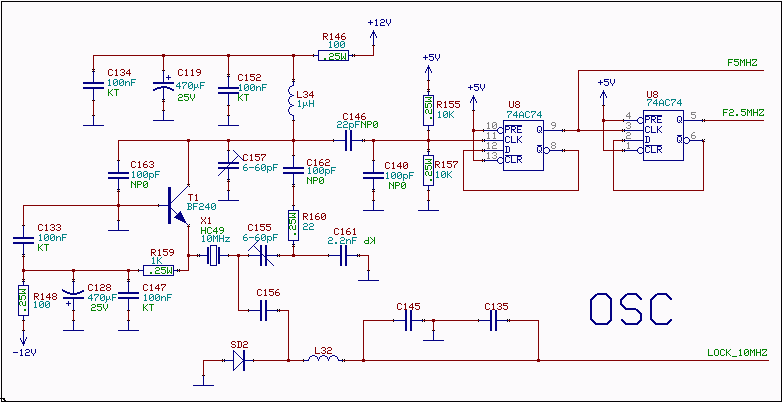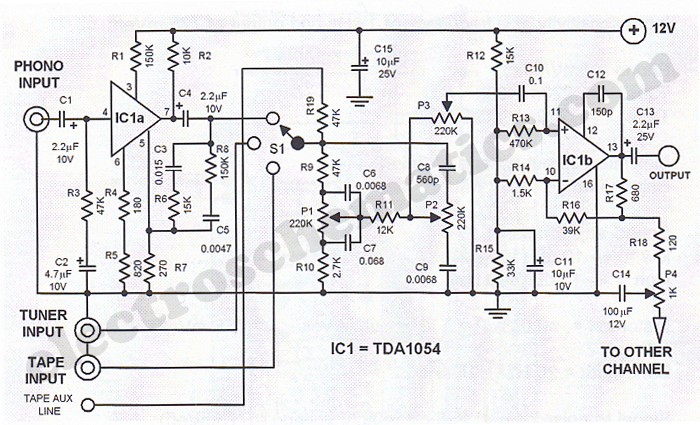
Code practice oscillator
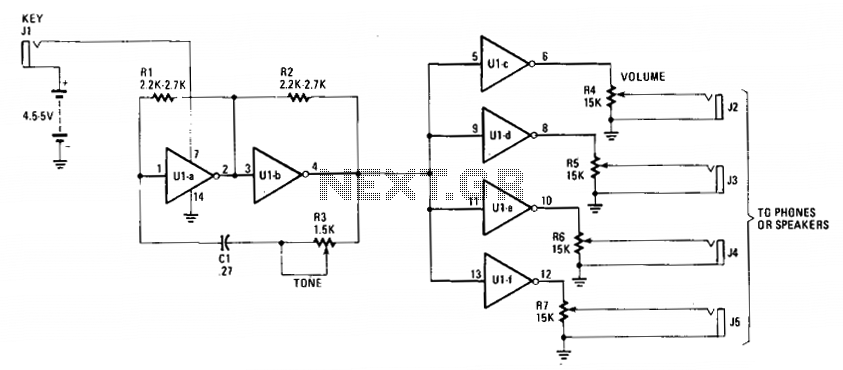
The cost-effective 7404 hex-inverter provides sufficient amplification to accommodate a broad spectrum of transducers. Engaging the switch completes the battery circuit, supplying four to five volts to the 7404. The bias for the first two inverter amplifiers (Ula and Ulb) is derived from two resistors, Rl and R2, which are connected between their inputs and outputs. A capacitor and rheostat (R3/C1) complete the feedback loop from the input to the appropriately phased output. The signal generated by Ulb drives the remaining four inverter amplifiers, Ulc through Ulf, which in turn drive the headphones or speakers. The volume control potentiometers, R4-R7, can range from 1500 ohms to 10,000 ohms, with lower values being more effective when used with speakers or low-impedance headphones.
The circuit utilizes the 7404 hex inverter as its main amplification component, which is capable of transforming input signals into inverted outputs. The design begins with the activation of a switch that connects the battery to the circuit, ensuring a stable voltage supply of four to five volts. This voltage is crucial for the operation of the 7404, enabling it to amplify signals from various transducers effectively.
In the initial stage, the first two inverter amplifiers, Ula and Ulb, receive their biasing through resistors Rl and R2. These resistors establish a feedback mechanism that stabilizes the input signal for optimal performance. The feedback loop is further enhanced by the combination of the capacitor (C1) and rheostat (R3), which not only fine-tunes the phase of the output signal but also helps in managing the frequency response of the circuit.
As the signal passes through Ulb, it is then transmitted to the subsequent inverter amplifiers, Ulc to Ulf. This cascading configuration allows for greater amplification of the audio signal, which is essential for driving output devices such as headphones or speakers. The final audio output is controlled through the volume control potentiometers (R4-R7), which can be adjusted to suit the user’s preference. The selection of potentiometer values is flexible, ranging from 1500 ohms to 10,000 ohms, with lower resistance values being particularly advantageous for applications involving speakers or low-impedance headphones. Overall, this circuit design exemplifies a robust and versatile approach to audio amplification using the 7404 hex inverter.The inexpensive 7404 hex-inverter has enough amplification to handle a wide range of transducers. Closing the key completes the battery circuit and applies four to five volts to the 7404. Bias for the first two inverter amps (Ula and Ulb) comes from the two resistors, Rl and R2, connected between their inputs and outputs. The capacitor and rheostat (R3/C1) close the feedback loop from the input to the properly-phased output.
The signal leaving Ulb drives the remaining four inverter amplifiers, Ulc through Ulf; they, in turn, drive the phones or speakers. The volume control potentiometers, R4-R7, may have any value from 1500 ohms to 10,000 ohms. The smaller values work best when speakers, or low impedance phones, are used.
The circuit utilizes the 7404 hex inverter as its main amplification component, which is capable of transforming input signals into inverted outputs. The design begins with the activation of a switch that connects the battery to the circuit, ensuring a stable voltage supply of four to five volts. This voltage is crucial for the operation of the 7404, enabling it to amplify signals from various transducers effectively.
In the initial stage, the first two inverter amplifiers, Ula and Ulb, receive their biasing through resistors Rl and R2. These resistors establish a feedback mechanism that stabilizes the input signal for optimal performance. The feedback loop is further enhanced by the combination of the capacitor (C1) and rheostat (R3), which not only fine-tunes the phase of the output signal but also helps in managing the frequency response of the circuit.
As the signal passes through Ulb, it is then transmitted to the subsequent inverter amplifiers, Ulc to Ulf. This cascading configuration allows for greater amplification of the audio signal, which is essential for driving output devices such as headphones or speakers. The final audio output is controlled through the volume control potentiometers (R4-R7), which can be adjusted to suit the user’s preference. The selection of potentiometer values is flexible, ranging from 1500 ohms to 10,000 ohms, with lower resistance values being particularly advantageous for applications involving speakers or low-impedance headphones. Overall, this circuit design exemplifies a robust and versatile approach to audio amplification using the 7404 hex inverter.The inexpensive 7404 hex-inverter has enough amplification to handle a wide range of transducers. Closing the key completes the battery circuit and applies four to five volts to the 7404. Bias for the first two inverter amps (Ula and Ulb) comes from the two resistors, Rl and R2, connected between their inputs and outputs. The capacitor and rheostat (R3/C1) close the feedback loop from the input to the properly-phased output.
The signal leaving Ulb drives the remaining four inverter amplifiers, Ulc through Ulf; they, in turn, drive the phones or speakers. The volume control potentiometers, R4-R7, may have any value from 1500 ohms to 10,000 ohms. The smaller values work best when speakers, or low impedance phones, are used.
